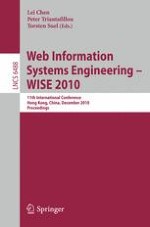th Welcome to the Proceedings of WISE 2010 — the 11 International Conference on Web Information Systems Engineering. This year, WISE returned to the place where the inaugural conference was held in 2000, Hong Kong. WISE has also been held in: 2001 Kyoto (Japan), 2002 Singapore, 2003 Rome (Italy), 2004 Brisbane (Australia), 2005 New York (USA), 2006 Wuhan (China), 2007 Nancy (France), 2008 Auckland (New Zealand), and 2009 Poznan (Poland). Continuing its trend, this year’s WISE provided a forum for engineers and scientists to present their latest findings in Web-related technologies and solutions. The submitted contributions address challenging issues in Web services, search, modeling, recommendation and data mining, as well as keyword search, social network analysis, query languages, and information retrieval and extraction. This year, WISE received 170 submissions from 25 countries, including Argentina, Australia, Austria, Belgium, Canada, China, Czech Republic, France, Germany, Hong Kong, Greece, Iran, Ireland, Italy, Japan, The Netherlands, Norway, Singapore, South Korea, Spain, Sweden, Switzerland, Taiwan, UK, and the USA. After a thorough reviewing process, 32 papers were selected for presentation as full papers – the acceptance rate was 18.8%. In addition, 19 papers were selected for presentation as short papers, yielding an overall acceptance rate of 30%.
